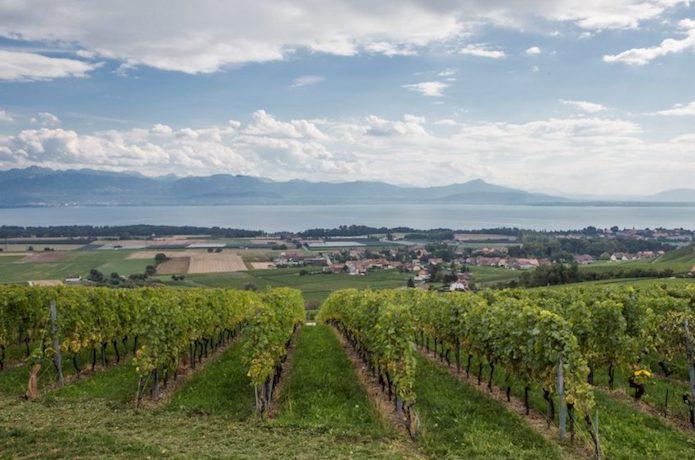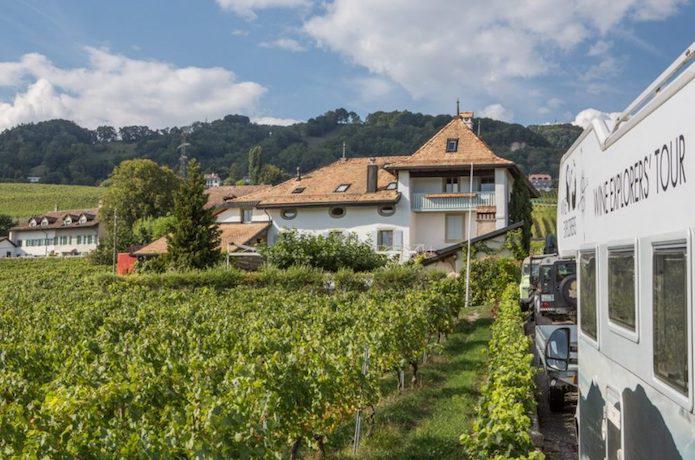Switzerland, a vineyard with 3 faces
- Thursday 24 November 2016
Text by Jean-Baptiste Anceloz, founder and writer of the Wine Explorers Blog, images by Luc Pollet.
I have been looking forward to talking about Switzerland. This is a country which I deeply love and where I had the chance to live a decade ago, for my first experience working in the wine industry.
Welcome to a territory of great wines, with green landscapes and a unique cultural diversity, in which 3 seemingly opposing worlds co-exist in perfect harmony.
Imagine : on the one side the French-speaking Switzerland. On the other side, the Ticino, where everything is only Italian. Between the two, the Swiss German – the biggest part – where the German language is king. And in the middle of all this, a “small” but charming area of vineyards of 15,000 hectares (the equivalent of the Alsatian vineyard – or 0.2% of the area of the world’s vineyards (1)), extending from east to west. Guided tour.
Discovering the wines of Aargau
The choice of which wineries to visit was complex, as there are many promising wine regions in Switzerland. From the Merlot of Ticino and the Gamay of Geneva to the Syrah and Chasselas of Valais, the Swiss vineyards harbor treasures. There are more than 200 varieties, many of which are indigenous (2).
We decided to explore the canton of Aargau in the north. A small corner of paradise nestled halfway between Basel and Zurich. We were expected by Rahel & Daniel Buchmann, from Buchmann Weine.
“The wines of Aargau benefit from a micro-climate very favorable to the maturity of grapes, with a beautiful south-southwest exposure, an average altitude of 500 meters, natural protection of forests and many old vines, as here with 40-years old riesling-sylvaner (3)“, Rahel, a young and brilliant oenologist who has just taken over from her parents at the 4 hectare family estate, explained.
The region is beautiful, wild and preserved. In the atmosphere, only the bells of the cows were ringing. The sky was clear and we could see the Swiss Alps in the distance. Time was about meditation.
Morning harvest in Chiquet-les-Vins
Continuing to the west, we headed towards the neighboring canton of Basel-Country, where Claude Chiquet welcomed us for a morning of harvesting under a soft late summer sun. Claude, who laughingly stated that he doesn’t know why he started in wine, put aside his past life in solar energies 10 years ago to plant a single hectare of vines in Ormalingen, his native village.
Starting from scratch, he wanted to make Chiquet-les-Vins a 100% organic estate from the beginning. Planting interspecific varieties – the famous PIWI (4) which we mentioned during our visit of the Belgian vineyards – were a natural choice for Claude. “New varieties such as Sauvignon-Soyhières or Cabernet-Jura need four times less treatment than classic Vitis vinifera and give very nice results here.”
And although I (still) have doubts regarding the complexity of wines made from PIWI, I must admit that the different cuvées of Claude pleasantly surprised me regarding both body and length. Could this be the exception that confirms the rule? A case worth following closely during future tastings of these new crosses…
Some Swiss wines we particularly enjoyed:
– Clos du Couvent 2008 (100% Chasselas), from Domaine de Maison Blanche
– Aspra Maisprach 2014, from Chiquet-les-Vins
– Mondeuse Noire & Pinot Noir 2009, from Domaine de Maison Blanche
– Mairah 2012, from Chiquet-les-Vins
– TEGERFELDEN Cabernet Dorsa 2013, from Buchmann Weine
On the shores of Lake Geneva
Add to an atypical character, an extraordinary encounter. Welcome to Yves de Mestral estate, in the Canton of Vaud. “What better way than a boat trip on the calm water of Lake Geneva offered by our host to better understand this unique terroir that is Mont-sur-Rolle?” Here we were, embarked on the yacht of Yves, enjoying an overview of the Vaudois vineyards.
A magnificent estate on terraces, with steep slopes and enclosed by walls, the Domaine de Maison Blanche proudly overlooks the shores of the largest alpine lake in central Europe, from which it draws light and energy.
The ideal equation for the cultivation of Chasselas, a white grape variety originating from the region, known for making light wines (or table grapes) and not always valued at its true potential.
A perfect challenge for this talented winegrower of well tempered character. He dared to experiment on his wines by ageing them on the lees or in barrels – which is unusual for this varietal – to the delight of our taste buds. His Chasselas are simply amazing, just like his cuvées of Mondeuse and Pinot Noir. A winemaker to discover urgently.
Gourmet escapade in the Fribourg Alps
It was impossible to leave Switzerland without (re)discovering the very famous AOP : Gruyère. This cheese of great complexity matches perfectly with Swiss white wines. A tour of the manufacturing process at the Maison du Gruyère highlighted the importance of every step, from the choice of the alpine milk (400 liters of milk needed for a 35 kg cheese wheel!), through the curdling, the salt bath, the cellaring and the maturation (between 6-9 months for a tender and fruity taste, and up to 24 months for thrill seekers). All of these processes will determine the aromatic palette of this cheese with a thousand and one perfumes.
With your fingers, on a piece of bread, melted, or as cheese soufflé, the Gruyère is a blast and makes you want to put on skis.
And for those who would still ask the question : no, it has no hole !!!











